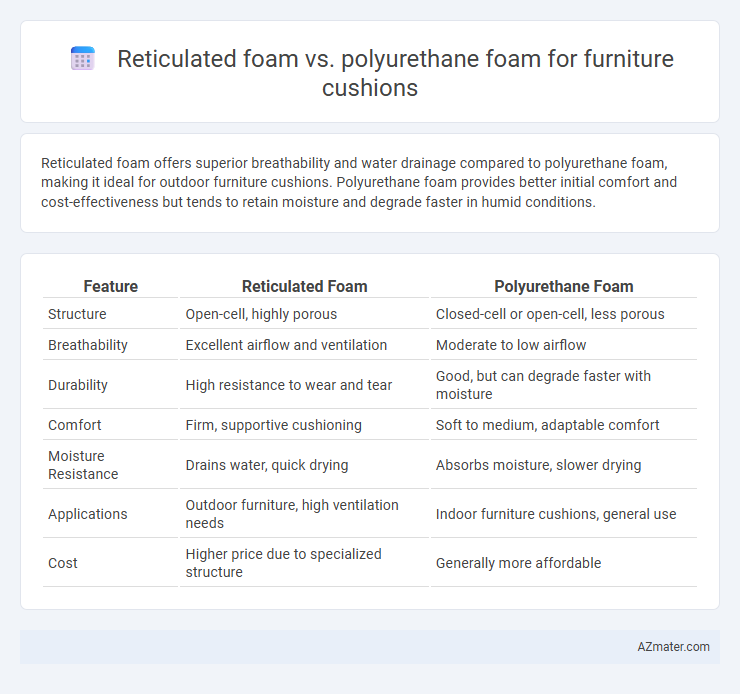Reticulated foam offers superior breathability and water drainage compared to polyurethane foam, making it ideal for outdoor furniture cushions. Polyurethane foam provides better initial comfort and cost-effectiveness but tends to retain moisture and degrade faster in humid conditions.
Table of Comparison
| Feature | Reticulated Foam | Polyurethane Foam |
|---|---|---|
| Structure | Open-cell, highly porous | Closed-cell or open-cell, less porous |
| Breathability | Excellent airflow and ventilation | Moderate to low airflow |
| Durability | High resistance to wear and tear | Good, but can degrade faster with moisture |
| Comfort | Firm, supportive cushioning | Soft to medium, adaptable comfort |
| Moisture Resistance | Drains water, quick drying | Absorbs moisture, slower drying |
| Applications | Outdoor furniture, high ventilation needs | Indoor furniture cushions, general use |
| Cost | Higher price due to specialized structure | Generally more affordable |
Introduction to Reticulated and Polyurethane Foams
Reticulated foam features an open-cell structure created through a process that removes cell membranes, resulting in enhanced breathability and water drainage properties ideal for outdoor and moisture-prone furniture cushions. Polyurethane foam, commonly used in furniture cushions, offers a denser, closed-cell design that provides superior support and durability but may retain moisture, affecting comfort in humid conditions. Selecting between reticulated and polyurethane foam depends on the specific application needs, balancing breathability with cushioning support.
What is Reticulated Foam?
Reticulated foam is a highly porous, open-cell foam commonly used in furniture cushions for its superior breathability and durability compared to traditional polyurethane foam. Its unique reticulation process removes cell membranes, creating a skeletal structure that enhances airflow and moisture drainage, making it ideal for outdoor or high-humidity environments. Unlike standard polyurethane foam, reticulated foam provides long-lasting support and resists mold and mildew buildup, improving cushion comfort and lifespan.
Defining Polyurethane Foam for Furniture
Polyurethane foam for furniture cushions is a versatile, synthetic material known for its excellent comfort, support, and durability. It is produced by mixing polyols and isocyanates, which react to form a flexible foam with various density and firmness options tailored for seating applications. Unlike reticulated foam, polyurethane foam maintains a closed-cell structure, providing superior cushioning but less breathability.
Key Differences in Foam Structure
Reticulated foam features an open-cell structure with a high level of interconnected pores, allowing superior breathability and faster moisture drainage compared to polyurethane foam's denser, closed-cell composition. Polyurethane foam provides robust support and cushioning due to its tightly packed cells, making it ideal for comfort and durability but less effective in airflow management. The choice between these foams depends on specific furniture applications where reticulated foam excels in ventilation and quick drying, while polyurethane foam offers enhanced resilience and cushioning performance.
Comfort and Support: Performance Comparison
Reticulated foam offers superior breathability and consistent airflow, resulting in enhanced comfort by preventing heat buildup during extended use. Polyurethane foam provides denser support with excellent cushioning properties, making it ideal for firmer seating and long-lasting durability. Comparing performance, reticulated foam excels in ventilation and softness, whereas polyurethane foam delivers firmer support and resilience for furniture cushions.
Durability and Longevity of Each Foam Type
Reticulated foam offers superior durability and longevity for furniture cushions due to its open-cell structure, which allows for enhanced airflow and faster drying, reducing the risk of mold and mildew. Polyurethane foam, while comfortable and affordable, tends to degrade more quickly over time with wear and exposure to moisture, leading to a compressed and less supportive cushion. Choosing reticulated foam extends the functional life of cushions in high-traffic or outdoor furniture settings by maintaining shape and resilience longer than traditional polyurethane foam.
Breathability and Moisture Management
Reticulated foam offers superior breathability compared to polyurethane foam due to its open-cell structure, allowing better air circulation and faster moisture evaporation. This enhanced airflow helps prevent mold and mildew buildup, making reticulated foam ideal for furniture cushions in humid environments. Polyurethane foam, while providing good cushioning, tends to retain moisture longer, increasing the risk of bacterial growth and reducing overall comfort.
Cost Considerations for Furniture Makers
Reticulated foam, known for its open-cell structure and superior breathability, typically costs more upfront than traditional polyurethane foam but offers enhanced durability that can reduce replacement frequency, impacting long-term expenses for furniture makers. Polyurethane foam is generally less expensive and widely available, making it a cost-effective choice for budget-conscious manufacturers, though it may require more frequent replacement due to faster degradation. Balancing initial material costs with lifespan and performance is crucial for furniture makers aiming to optimize production budgets without compromising product quality.
Sustainability and Environmental Impact
Reticulated foam offers greater sustainability in furniture cushions due to its enhanced durability and longer lifespan compared to traditional polyurethane foam, reducing the frequency of replacement and waste accumulation. Polyurethane foam, often derived from non-renewable petrochemicals, tends to release volatile organic compounds (VOCs) during production and degradation, contributing to indoor air pollution and environmental harm. Choosing reticulated foam with eco-friendly manufacturing processes and recycled content can significantly lower the environmental footprint of furniture cushions, promoting greener living spaces.
Choosing the Right Foam for Your Furniture
Reticulated foam offers superior breathability and durability, making it ideal for outdoor or high-traffic furniture cushions, while polyurethane foam excels in comfort and affordability for indoor use. Selecting the right foam depends on factors such as intended usage, desired firmness, and environmental exposure. Consider reticulated foam for enhanced airflow and longevity, and choose polyurethane foam for softness and cost-effectiveness in typical indoor settings.

Infographic: Reticulated foam vs Polyurethane foam for Furniture cushion
 azmater.com
azmater.com